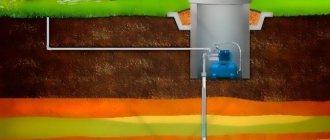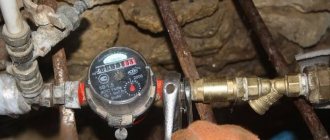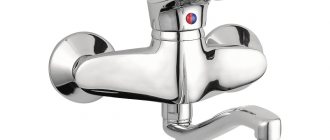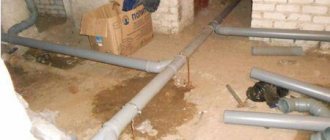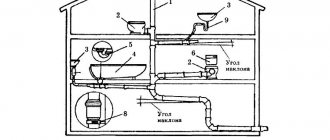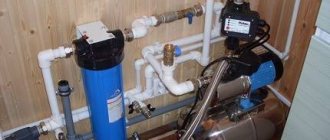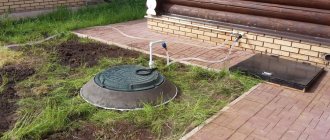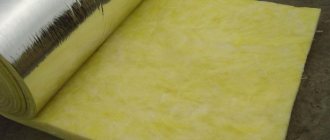The use of precipitation will provide significant savings in water extracted from a well or well. In addition, it will help reduce energy consumption, as it allows you to turn on pumping equipment less often. However, you don’t know how to collect nature’s free “gift” for further use?
We'll show you how to do this. The article discusses a rainwater collection system and options for using precipitation for domestic needs. The device, design specifics are described, and the effectiveness is assessed taking into account the funds spent on organizing an alternative water supply.
For interested visitors, we have selected organizational diagrams with underground and above-ground reservoir locations, presented photos with options for masking the storage tank, and collected useful videos that allow you to organize water collection on your own.
How can rainwater be collected in a country house?
In order to collect rainwater at the dacha, it is necessary to use special devices.
First of all, it is necessary to equip the building and its roof with a special drainage system. Then you need to place the container itself under the drain. The container can be dug into the ground, or it can be placed on the ground. The volume of the container depends on the amount of precipitation, as well as on the duration of the rain. Although it is worth saying that not all regions can use rainwater even for household needs. There are regions near which large chemical plants are located, or megacities that produce large emissions into the atmosphere. All this makes rainwater even more dangerous, which immediately excludes the option of using it for economic purposes. Even if such water is filtered, it is almost impossible to ensure its quality. After all, today household filters are designed to remove completely different contaminants, and not those found in rainwater.
Urban rooftop farm on an industrial scale
Details Created on 08/25/2013 09:50
Written by Natali
A few years ago, the idea of a large-scale commercial urban farming operation that could provide locally produced food seemed impossible. Increasingly, urban farms or “rooftop farms” have appeared on the roofs of high-rise buildings, municipal buildings or just small residential buildings, helping people get the fresh fruits and vegetables they need and pleasant coolness during the hot season.
This business development model seemed very attractive to the agricultural company Lufa Farms and now it is opening its second, largest to date, urban farm north of Laval, Canada.
The farm is located on the roof of a building that houses a furniture store and other commercial tenants, and occupies 4,000 square meters.
Articles tagged
Distribution
Old barrels and watering cans have advantages: with their help, the organization of moisture supply is carried out purposefully and without much pressure directly down to the plants. At the same time, the gardener knows how often the container is filled and what the consumption is.
Depending on the properties of the soil, two people can complete the job in half a day. A Platin plastic container with a capacity of 1500 liters is buried in the ground
The tank is filled with rainwater from a drainpipe through communications laid in the ground. To water the area, they then use an electric pump built into the tank, which turns on and off automatically
Micro-house Ecocapsule enters the market
Details Created on 02/09/2018 13:28
Written by Natali
Facepla.net has been following the Ecocapsule solar and wind micro-home since the prototype stage. Now, almost 10 years after the fantastic concept was conceived, its Bratislava-based designers are finally making their international debut with the exclusive release of 50 off-grid micro-homes that can be installed almost anywhere.
While this set of smart, self-sufficient tiny homes will only be available to customers living in the United States, Japan, Australia and the EU, a second production series will follow in late 2018.
Articles tagged
Rainwater treatment for domestic needs
If you want to use rainwater for domestic purposes and want to install a filter to further purify it, you need to follow a few steps to ensure you have fresh, clean water.
Purifying water from bacteria
Since most bacteria enter rainwater from the roof and gutter system (where the water picks up bird feces, etc., as well as other organic matter), pre-filtration is a very important step for purifying and storing fresh water.
If you use your roof and gutters to collect rainwater, you will need to install a special device that will allow you to discharge the water received in the first few minutes after the downpour into the drain. The fact is that in the first minutes after the rain begins, all contaminants from the roof and other elements of the structure for collecting rainwater are washed off and fall into the fresh water storage tank.
It is especially important to drain such water if the weather was dry for several days before the rain; in such weather, pollution accumulates on the roof very actively. In addition to bird feces, there may also be leaves and branches on the roof. Filtering such water is very difficult, and not rational, because mechanical debris will quickly contaminate the filter, and further purification of the water will no longer be possible
Filtering such water is very difficult and not rational, because mechanical debris will quickly contaminate the filter, and further purification of the water will no longer be possible.
We drain the water obtained in the first five minutes into rainwater drainage trays and purify the rest of the water. Despite the fact that we will get rid of the bulk of the garbage, you still need to purify the remaining water from bacteria, as well as mechanical debris.
Pre-filter
A pre-filter is necessary in order to prepare water as efficiently as possible for further storage in the tank. The fact is that if you send untreated water into the tank, it will not be stored for that long. Reducing the shelf life is not advisable, since it is unlikely that you will be able to use rainwater immediately after a rainstorm. It is best to ensure cleaning not only from debris, but also from bacteria. Although it all depends on what purpose the rainwater will be used for. For example, water for watering a garden can only be purified from debris. There is no need to remove bacteria.
Beware of lead!
But if the roof or drainage system contains elements of lead and heavy metals, it is not recommended to collect such water.
Delivery of water through such pipes also significantly reduces water quality. It is strictly not recommended to use water from a roof covered with asbestos slate! This material contains asbestos fibers, which can cause serious illness.
Water collected from a roof made of galvanized iron, metal tiles, flowing through drains made of tin or polyvinyl chloride is quite usable.
Stylish drain
The water collection system in a country house or country house is a rather bulky and unattractive structure. In order to somehow decorate and ennoble it, people invent such masterpieces that one can only be amazed.
If the drain is adjacent to an unpainted wall, home-grown artists paint intricate scenes on it, “weaving” the drain pipe into them.
For those who like the sound of rushing water, you can prolong the pleasure by making the drain not a straight line, but a broken line. Such structures are created from either solid or sawn lengthwise pipes.
Nowadays, no one will be surprised by the flower beds that are located under the drain. But not everyone would think of placing hanging flowers directly on a drainpipe.
Moreover, the design can be improved in such a way that the draining water gets into each flower pot.
Another non-standard approach is to use a hanging system of teapots, old dishes, unnecessary things, chains, and plastic bottles instead of a pipe.
It happens that the owners do not have the makings of an artist, but there is a desire to decorate the drain pipe.
For this purpose, there are special figurines and decorative attachments made of clay, iron and plastic on sale. A drain structure decorated in this way looks unusual and original.
A reasonable design will help to significantly save water resources without using a central water supply and pumping station.
Inventory storage areas
Just making a system for collecting water from the roof is half the battle. You need to think about where the flowing water will be delivered: directly to the house or to water storage tanks.
In order to filter the water so that leaves and large debris do not fall into the drain pipes, nets are installed on the barrels. This safety measure will also help protect animals and children from harm.
Water collection ideas depend on the location of the drain pipes. The containers are dug into the ground, placed in basements, on the roof of the shower.
A little trick - if the tanks are placed on a slight elevation, the water will be used by gravity without connecting a pump.
One thing is certain: the tanks must be made of environmentally friendly material, plastic, galvanized iron or wood.
Another option is an improvised well. They dig a hole and cement it for strength, or install concrete rings in it. A concrete cover is placed on the bottom.
After draining from the roof, the water ends up in a storage tank or filtration tank. In the first case, water flowing from the roof flows by gravity into a placed barrel.
The second option is how to collect water from the sewage system, if residents of a country house need its supplies more often than summer residents who live in the house “in transit.”
For these purposes, several containers are installed in the basement, connected to each other using plastic pipes, which are inserted using detachable connections into the lower part of each barrel.
Water will be supplied to the house and gardens using a pump. This system can also be installed near the wall of the house. From the point of view of aesthetics, it is recommended to install it out of sight, for example, hide it behind the house.
Special drains for collecting rainwater
Some gutter system manufacturers offer parts that are specifically designed for the water collection system. These can be grilles that protect the drain from leaves and large debris. In order not to completely close the drain, you can limit yourself to a barrier placed in the pipe. For storing water in a barrel, taps are convenient, they direct the water into the container, and when it is full, they drain the water to the area.
Above ground rainwater tanks can be placed in the home, specifically in the basement. They are good to use in cases where the site is already equipped and there is free space in the basement. In the room with tanks, the temperature should not fall below 0°C. Above ground tanks can hold 750, 1,100, 1,500 or 2,000 liters. The width of these products usually does not exceed 80 cm, which makes them easy to transport, including through the door. Individual tanks can be combined into batteries to provide the optimal volume for a particular room and home, depending on the tasks.
Underground tanks are preferable if you have limited space in your home. In this case, the necessary condition is a low groundwater level. Underground tanks can have a volume of 2000 or 3000 liters. The size of the pit for the tank must be such that, in addition to it and the incoming pipe, a layer of coarse sand with a thickness of at least 20 cm can be placed around it. Then the soil pressure on the tank will decrease. The layer of earth above it should not exceed 50 cm.
The capacity of the tank should not be too large so that in the event of an accident or prolonged rains, the accumulated water can go into the storm drain (if the tank is connected to it) or directly onto the site. It is better to connect the tank to the sewer. This is done using a siphon. Thanks to it, the tank is not only freed from excess water, but also receives protection from unpleasant odors from the sewer. It is better to equip such a connection with a special valve that will prevent the return of water from the sewer.
If there has been no rainfall for a long time or the water from the rain tank is completely used up, it must be filled with drinking water. It is best to provide automatic filling with water from the tap. The tank must be tightly closed to prevent mosquito breeding, insects and small animals from entering. Some models of rainwater storage tanks have a built-in pump and filters, and also provide the ability to attach additional containers.
What is drainage
The purpose of the drainage system is to collect excess moisture from the soil, that is, to drain it. The task of the system is to prevent an excessive rise in the groundwater level so that the site does not turn into a swamp. Most often, drainage is done on swampy soils.
The way to check the humidity level is to dig a hole half a meter deep in any area of the dacha. If after a short time (without rain) water accumulates there, you need to build a drainage system. Otherwise, the water will begin to wash away and destroy the foundation of all buildings.
Types of drainage
There are surface and deep drainage sewers.
The first option has two subtypes:
- Linear system. Trenches are dug on the soil surface along the entire perimeter of the site. Snow and rainwater flows into the depressions. The network works on flat surfaces without sudden changes in height. The depth of the trenches is up to 30 cm, the bottom and walls are covered with fine gravel. Advantages: simplicity and efficiency of arrangement. The downside is the need to clean the ditches from debris.
- Point drainage. The simplest type is to install water collectors at points where liquid drains abundantly. These can be drains, natural depressions in the soil. Barrels are placed under drains, and in ravines open containers are buried in the ground.
Expert opinion Vladislav Ponomarev Design engineer, inventor
To form surface drainage, no complex calculations are made. The system is equipped “by eye”.
Deep drainage is a complex network of channels and pipelines that drains moisture into special structures or ditches outside the site. Sewerage is carried out with preliminary accurate calculations in accordance with geological survey data. Deep drainage is required in areas with sharp changes in relief and abundant groundwater at shallow depths.
Loading …
Diagram of a system with an underground tank
A large container installed near the house can satisfy 50% of the water requirement. Thanks to special wiring, rainwater will flow to water collection points that do not require high quality liquid: toilet cisterns, kitchen and watering taps. But even in this case, filters are installed.
The reservoir can be installed under the drainage system on the surface, in the basement or in a pit dug near the house. We will choose the third option, in which the container will be completely immersed in the ground, therefore, it will not occupy a free area near the building and will not spoil the beautiful landscape with its technological appearance.
Another advantage of a reservoir buried in the soil: cooled rainwater is an unsuitable environment for the development of bacteria, therefore it will not “bloom”
We select a container with a volume of 2.5-3.5 thousand liters, and, based on its dimensions, we look for a place for installation. In addition to the dimensions, when digging a pit, we must take into account the groundwater horizons and the level of freezing.
The depth of the pit should be approximately 70 cm greater than the height of the tank, since 20 cm is a gravel-sand cushion, 50 cm is a layer of earth above the tank (freezing in the middle zone and northern regions in winter).
Next we proceed according to the scheme:
- We take out the soil and take the excess to the side;
- we arrange a compacted gravel-sand cushion;
- We install a reservoir in the center of the pit;
- fill it on all sides with a mixture of soil and sand;
- we install pumping equipment and pipes (drainage and leading into the house).
Of course, before connecting electrical equipment, it is necessary to establish a water supply system from the roof and make internal wiring. Installation of drains occurs in the traditional way, a pipe through a hatch supplies water to the container.
The pipeline from the tank leads to certain, pre-selected points. Inside the house, in the utility room or basement, there is a place for installing a pump, filters, and control equipment.
Scheme of using a rainwater collection system: 1 – water level sensor; 2 – float device; 3 – filter; 4 – surface pump; 5 – water tank; 6 – siphon; 7 – filter
After installation and connection, it is necessary to perform a test start: fill the container with water and turn on the pump. If everything is in order, the liquid will quickly flow to the water collection points.
The container should not be empty, as ground movements can cause deformation of the body. If water runs out during a drought, it must be replenished from the main source. In order not to measure the water level using improvised means, you can draw a kind of scale on the inside of the wall with divisions in fractions or liters.
Precipitation Application Options
Everything is in order with fresh water reserves in Russia, but the most economical owners of private lands have increasingly begun to think about the rational use of natural resources.
Along with solar panels and homemade wind turbines, they create universal rainwater collection systems that provide positive results on dry days or during periods when the water in the well runs out.
Excellent practical experience exists in Germany, Holland, Belgium and other European countries. Considering that it is simply impractical to waste tap water on flushing a toilet tank, Europeans have come up with many schemes for using absolutely free, but no less useful natural water.
The diagram of a home water supply system includes the following important components: a water collection field (roof), pipeline, storage tank, pumping equipment, filtration system
Thanks to the use of rainwater, the cost of depreciation of pumping and cleaning equipment is reduced, and personal budget savings occur.
The system is so simple that in the absence of a completely finished factory model, you can always assemble it yourself.
The main purpose of the drainage system is to collect the maximum amount of rainwater and move it to a storage tank. The liquid is then used for various household needs: washing, washing, cleaning, watering.
No additional purification is needed for watering, but for showering or washing dishes, the water must be filtered. For this purpose, several filters are installed into the water supply, and both coarse and fine cleaning will be required.
To drain excess water or carry out cleaning procedures, another hole is drilled in the tank and a pipe leading to the sewer system is installed.
A reserve container of water can help out both in case of a shortage of water from the main source, and in the event of force majeure.
If you decide to clean the well, then the large tank will allow you to wash, wash, and water your garden crops. Instead of one container, you can install several, then you won’t have to save money.
System Setup
Catch the rain
, a 2022 book about rainwater harvesting
Rainwater harvesting systems can range in complexity, from systems that can be installed with minimal skill to automated systems that require extensive setup and installation. A basic rainwater harvesting system is more of a plumbing job than a technical job, as all exits from the building's terrace are connected by a pipe to an underground reservoir that stores the water. Such systems install common components such as pre-filters (see, for example, vortex filter), drains/gutters, storage tanks, and depending on whether the system is pressurized, also pumps and treatment devices such as UV - lamps, chlorination devices and post-filtration equipment.
The systems are ideally sized to meet water requirements during the dry season as they must be large enough to support daily water consumption. In particular, the rain catchment area, such as the roof of a building, must be large enough to maintain adequate water flow. The size of the water storage tank should be large enough to accommodate the captured water. Low-tech rainwater harvesting systems use many low-tech methods: rooftop systems, surface water capture, and pumping rainwater that has already soaked into the ground or is captured in reservoirs and stores it in reservoirs (cisterns).
Before a rainwater harvesting system is built, the use of digital tools is useful, for example, to determine whether a region has high rainwater harvesting potential or to estimate the amount of water needed to meet a community's water needs. These tools can save time and money before committing to building a system, and make the project sustainable and long-term.
Construction of an eco-mosque in Turkey
Details Created on 02/08/2013 09:34
Written by Natali
Surrounded by mountains, Turkey's fourth largest city, Bursa is already one of the country's greenest metropolises and is set to become even greener.
An eco-mosque is planned to be built in the western part of the city, where it will produce 120 kW of electricity from solar and wind energy. The building will consume 50kW, selling the rest to the national grid. Construction is scheduled to be completed in 2015.
Turkey already has one eco-mosque that generates and uses solar energy. The mosque is located in a village in Akkuyu province.
But the Bursa mosque will be the first mosque designed to produce and consume renewable energy.
COLLECTING RAINWATER FOR IRRIGATION - USEFUL DEVICES
IT IS DIFFICULT TO FIND A HOUSEHOLDER WHO DOES NOT USE RAINWATER FOR ECONOMIC PURPOSES. FOR CONVENIENT COLLECTION, VARIOUS DEVICES CAN BE INTEGRATED INTO THE DRAINAGE SYSTEM.
Of course, the easiest way is to place an old barrel under the drain. However, in case of overflow, it is necessary to organize the drainage of water away from the house, otherwise it will erode the soil, creating mud in front of the building or, even worse, reach the underground part of the foundation.
PLASTIC INSERT-FILTER
In a house equipped with a storm water drainage system, you can use a special plastic drainage container to fill the container. It is built between two sections of the drainpipe, without dismantling the latter entirely. The body of the water collector includes a pipe for connecting a tee nozzle or a hose directly, through which water will flow into the storage tank (Fig. 1). As soon as the barrel is filled (Fig. 2), the height of the water in the device will reach a critical level,
and it will begin to pour into the drain pipe. Thus, the water collector has overflow protection, operating on the principle of communicating vessels. Thanks to it, water flows will not wash away the foundation and seep into the basements - they will go through the drain into the drainage or sewer system.
The water collector has a lid and a mesh filter. The first is made of soft plastic, which is easily cut into notches to suit any shape and diameter of drainpipes (65-100 mm). The mesh allows you to retain fallen leaves and small debris.
A similar device is manufactured, for example, by the Canadian company Murol. Its rainwater collectors are produced in a wide range of colors and are suitable for not only round but also rectangular pipes. Drainage elements of a similar design are also produced by the Polish company Cellfast (trademark Bryza). However, its products can only be used for round gutters 0 90 mm.
Plastic inserts have only one disadvantage: when passing through them, the water does not completely go into the storage tank, since some of it also enters the drain, which means that it will not be possible to quickly fill the container.
RAIN VALVE
The design of such drainage systems as Aquasystem and Zambelli provides for a ready-made catchment. This element is a section of pipe with a short groove: if necessary, it can be opened and fixed in an inclined position, like a door (Fig. 3). In this case, the water will begin to flow down it directly into the barrel. After filling it, the gutter can be easily returned to its place, and the pipe will continue to perform its normal functions. A round-shaped metal part with frequently spaced holes is used as a filter. It is not necessary to install it, but it is still recommended.
Unfortunately, this method of water collection has significant disadvantages. First, the valve can only be used with a specific manufacturer's drain. Secondly, it does not have overflow protection, which means you will have to monitor the process of filling the tank.
However, there is an advantage: the design of the folding chute is simple, and if desired, it is not difficult to make it yourself. To do this, it is best to use a piece of pipe of the same diameter as the drain.
All you need to do is make a gutter from it and secure it in a pre-cut hole in the drainage system.
At the same time, comparing both devices - a rain valve and a plastic insert, it must be admitted that using a plastic water collector is much more convenient.
Principle of operation
Not every roof is suitable for collecting precipitation and this should be taken into account when installing the system. Ideal drainage is provided by a pitched or gable roof with a slope of 10 degrees or more. A flat roof leads to stagnation of water and the formation of harmful bacteria in puddles.
We do not recommend drainage from any roofs covered with chemically active materials. This applies to slate (asbestos is released) or copper tiles (water oxidizes).
The following are considered safe materials:
- clay;
- bitumen,
- plastic;
- galvanized metal.
The same high demands are placed on storage capacity. The reservoir must not interact chemically with water. The ideal choice would be a well made of concrete rings, a tank made of polyethylene or galvanized metal. The tank can be installed both on the surface and in a specially dug pit.
The installation method is largely determined by the size of the container. The larger it is, the more difficult it is to place it on the site. The buried container looks aesthetically pleasing and facilitates long-term storage of water due to low soil temperatures. But a surface barrel has its own advantages, which are very important for summer residents. Installation does not take much time and does not require special labor costs. It is easy to scoop water from the barrel for irrigation - no need to buy a separate pump.
Consequences
If a person, despite the recommendations of doctors and scientists, drinks rainwater, the following side effects will occur:
- Infection with bacteria with the formation of vomiting, diarrhea, nausea, intoxication of the body with a rise in body temperature.
- Entering the digestive tract of helminthic infestation; in case of complications, the parasites spread to the liver, kidneys, and other internal organs.
- Infection with protozoa, the disease can occur in a latent form, emerging during periods of severe complications (for example, with hepatitis).
- Ingestion of chemical compounds into the body that leads to malfunction of internal organs.
- Mixed infection, for example, when infected with fungi, bacteria, worms.
- Oral diseases (stomatitis, periodontitis, gingivitis, candidiasis).
- Disturbance of intestinal microflora with the development of dysbacteriosis.
Serious consequences can occur instantly. For example, when infected with an intestinal infection. Fever, diarrhea, and vomiting develop rapidly.
However, when a helminthic infestation occurs, tissue damage occurs more slowly. A person does not immediately notice that he is infected. This is why rainwater is especially dangerous.
Installation
Installation of a rainwater collection system includes several main steps:
- A pit of the required depth and a trench for laying water pipes are dug.
- A cushion of sand and crushed stone with a thickness of at least 10-15 centimeters is poured onto the bottom of the pit and trench.
- For the pipeline, standard PVC products for outdoor use are used.
- Forced pumping is provided by a surface centrifugal pump. You can also use a compact submersible model. For example, Forward FWP-550J. This model costs an average of 1,800 rubles and is capable of working at a depth of up to eight meters.
- The tank is lowered into the pit. To ensure stability, it is sprinkled around the perimeter with sand or gravel (relevant for plastic products).
- Pipes and pumping equipment are connected, after which the tank neck is closed with a lid. For all-season use of the system, the lid is insulated, and the pump is placed in a warm room or coffered chamber.
- To connect the drain and the pump, two adapters are used, which cut into the body of the tank.
To prevent debris from entering the tank, mesh filters are installed at the drain necks to trap dust and organic debris. During operation, filters are regularly cleaned of blockages. It is recommended to install them specifically on drains. When installed on the neck, it will be quite difficult to carry out maintenance, especially if the tank cover is covered with insulating material.
Many online stores offer special storage tanks. Most often, large-capacity water collection containers are made by manufacturers from various polymers. In terms of materials, in this case, the owners have little choice.
You can purchase a model for underground installation at a price ranging from 25,000 (1,600 liter tank) to 100,000 rubles (6,500 liters).
Above-ground containers can be in the shape of an amphora, tank or column. Capacity from 300 to 500 liters. Includes a lid to keep debris out and a stand (on some models). Average cost from 3,000 rubles. Surface models have a pleasant design (color, shape) - they are easy to match to the specific facade of the house.
How to collect rainwater
In order to organize the collection of rainwater, you need a roof with a slope of 10 degrees or more, gutters, downpipes, filter grids, connectors, a pump (if necessary) and a storage tank of significant size.
Downpipes are not just for nocturnes, and gutters can be not just functional, but also beautiful
Rainwater harvesting makes sense if you have a pitched or gable roof. On flat roofs, water stagnates and harmful bacteria multiply in it. Such water will not benefit either you or your plants.
It is undesirable to use rainwater on the farm if there is an industrial enterprise or a large city nearby.
Roofing, gutters and pipes made of materials containing copper, lead, asbestos and other substances that can have a negative impact on human health should not be used to collect rainwater. Ceramic tile roofs are safe, but only if you do not coat them with various protective compounds.
Owners of roofs made of classic asbestos-containing slate or the now popular copper tiles will have to look for other sources of water for irrigation
To collect rainwater, you will need any storage container, for example, an old barrel. The material from which this container is made should not change the chemical composition of the water. Most often, gardeners use barrels made of polyethylene, food-grade plastic or galvanized steel. There are several options for placing the container:
- it can be installed above ground level, which will allow you to use water for domestic needs without a pump;
- you can dig a barrel into the ground, which often looks more aesthetically pleasing and also inhibits water blooms; but this will require excavation work, the organization of a sand or sand-gravel bed, etc.;
- some place water collection tanks in utility rooms.
The color of the barrel also matters. In dark containers, water warms up faster and is therefore suitable for summer showers. Light and reflective surfaces, on the other hand, prevent the sun from heating the water too much. As a rule, in this case it is more suitable for watering.
To prevent the water from clogging, as well as to protect children and your pets, the container is equipped with a securely closing lid into which a drainpipe is cut.
Water in containers that are not covered with a lid quickly becomes clogged and blooms, which automatically reduces the options for its use.
In order to avoid unpleasant surprises, it is important to think about how to ensure that excess liquid is drained into the sewer, since rains are often prolonged, and you may not be at the dacha at the most crucial moment. To prevent flooding of the area, a drain can be made in the upper part of the barrel leading to the sewer. It is advisable to install non-buried barrels on a drainage base - a grate or large pebbles with a mandatory groove for drainage of excess water
It is advisable to install non-buried barrels on a drainage base - a grate or large pebbles with a mandatory groove for the outflow of excess water.
To protect your gutters from clogging, you need to cover them with mesh (today you can find gutters that were originally sold in this configuration). Also, a filter mesh must be installed at the junction of gutters and drainpipes. Gutters must be regularly cleared of accumulated debris.
Pipes are selected depending on the volume of the drain; usually their diameter ranges from 8 to 30 cm. If you decide to do without drain pipes, then to reduce splashes from falling water, you can use chains of various traditional and original shapes.
In general, collecting rainwater is a simple and inexpensive task. But so that your efforts in installing drainpipes and gutters are not in vain, read how to water plants correctly:
Installation of drainpipes
Installation of the drainage system is done before roofing work - then the fastening elements can be easily attached to the rafters or roof sheathing. They can also be fixed to a special mounting board. When attaching to the sheathing, use longer hooks, and if the brackets are installed on a board, then you should choose fasteners of a shorter size.
We advise you to read about how to independently install a instantaneous water heater, a septic tank, as well as how to make water supply from a well.
Made of plastic
Many elements and components of this lightweight structure can be assembled at the bottom and then only lifted up and properly secured. To cut plastic elements, use a hacksaw or metal saw. The edges are smoothed with a hacksaw or sandpaper. Fastening elements (brackets) are installed ahead of time.
When installing plastic drainage systems, the following work is done:
- First, mark the places for attaching the brackets, while moving 15 cm away from the corner of the roof. The distance between them is no more than 0.5 meters. The height difference should not be more than 5 mm per meter. In this case, you should also take into account the slight slope of the gutter towards the drain pipe. The optimal slope is considered to be 3-5 mm per 1 meter;
- The outermost elements are attached first - the topmost bracket and the bottom one;
- Plastic gutters are installed on brackets and connected to each other. The connections must be completely sealed;
- cut holes for drainage;
- install drain funnels;
- all joints are sealed;
- Under the drain funnel, clamps are attached for installing pipes at a distance of 2 meters from each other. To mark the fastening points, use a plumb line;
- First, an inclined elbow is attached under the drain funnel;
- Pipes are secured under the inclined bend, connecting them to each other using couplings and securing them with clamps;
- A discharge elbow is installed at the bottom of the drain pipe.
You may also need to know how to build a cellar in a garage, how to get rid of groundwater in the basement, and how to make lighting for a country house.
Metal system
When installing a metal drainage system, the following steps are performed:
- fasten the brackets at a distance from each other of no more than 0.6 meters, taking into account a slight slope (2-5 mm per 1 m). A pair of brackets are installed at the drainage point for the funnel;
- installation of gutters. They are inserted into the grooves of the brackets and clamped with a latch. Metal gutters are cut to the required length with a hand metal file and then the cut area is processed using a fine file. Two gutters are connected with an overlap of 5 cm, and the upper part of it should be directed towards the slope to avoid leakage;
- plugs are installed on the edges of gutters that do not lead to drains and sealed with rubber gaskets or sealant;
- install drain funnels and protective nets;
- a drain elbow is attached to the drain funnels;
- mark the mounting locations for the pipes, first attaching them to the drain elbow;
- installation of clamps in the designated places on the wall;
- pipe installation. The pipes are connected to each other to the required length and secured with clamps, fixing the removable part of the clamp with bolts and screws;
- drain elbows are attached to the lower ends of the pipes, draining water from the roof away from the walls and foundation.
How to organize water drainage on the site
This task is complex; it includes systems that complement each other:
- drainage system;
- surface drainage system;
- drainage system.
Using the first two systems, rain and melt water can be drained away. These types of groundwater are seasonal and pose a significant problem for houses with a basement. In addition, they can instantly fill a cesspool during floods.
If there is a roofing system, rainwater quickly accumulates and is drained to the catchment area. If there is no drainage, then very soon the rains will simply break the steps, blind area and all the paths near the building. The remaining melt and storm water is eliminated using surface drainage.
If the basement is flooded with water, and at the same time the cesspool needs to be pumped out weekly, then deep drainage will have to be performed.
Important points of operation
If you plan to deepen the storage tank, it is necessary to take into account the depth of groundwater and the freezing point of the soil in winter. In situations where the terrain allows you to dig a pit of the required depth and place a reservoir of two or three thousand liters in it, the owners can safely install technical water supply.
When using the system seasonally for the winter, it is necessary to drain the water, dismantle the pump, and cover the tank lid with insulation (for example, fallen leaves or a thick layer of sand).
If electric heating of vertical drains that remove moisture from the roof is used, the system can be used all year round. To do this, the reserve tank and service water supply are lowered into the ground below the freezing point, the pump is placed in a warm utility room, and the tank lid is additionally insulated.
To prevent leaves, dust and other debris from entering the tank, mesh filters must be used. It is also recommended from time to time to drain the top water touching the tank lid - this is where debris most often accumulates. Complete cleaning of the container is done using chlorine bleach. After chlorination, water should not be used for irrigation or bathing.

